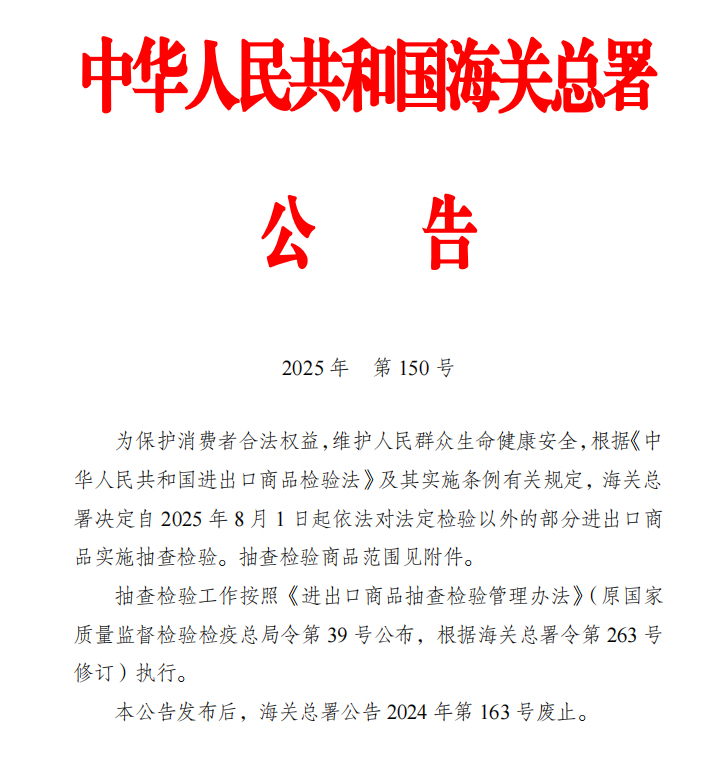Recently, the General Administration of Customs (GAC) issued Announcement No. 150 of 2025 on conducting random inspections for import and export goods not subject to statutory inspection in 2025.
In accordance with the Law of the People’s Republic of China on Import and Export Commodity Inspection and its implementing regulations, the GAC has decided to implement random inspections on selected import and export goods outside the statutory inspection catalog, effective August 1, 2025.

Random Inspection Product Scope
Imported Goods:
01 Student stationery, infant and children’s products, electronic goods, household appliances, low-voltage electrical equipment, daily-use accessories, etc.
Exported Goods:
02 Children’s toys, lighting products, low-voltage electrical equipment, functional apparel, etc.
-2048x1365.jpg)
-2048x1365.jpg)
Comparison with GAC Announcement No. 163 of 2024: The General Administration of Customs (GAC) has expanded the scope of random inspections for exported goods this year. In addition to children’s toys, three new categories—lighting products, low-voltage electrical equipment, and functional apparel—have been included. Enterprises involved in these sectors should ensure compliance readiness.
Random Inspection Scope for Non-Statutory Goods in Past Six Years
This June, the Commodity Inspection Department of the General Administration of Customs released the latest quality and safety inspection results for import and export goods not subject to statutory inspection.
From November 2024 to March 2025, customs authorities conducted random inspections on 782 batches of products, mainly covering four categories of import and export goods, including imported student stationery, children’s clothing, electronic products, and exported children’s toys. A total of 77 batches failed inspection, representing an overall failure rate of 9.8%.
The failure rate for children’s clothing reached 10.8%. Reasons for non-compliance included: excessive formaldehyde content, presence of prohibited aromatic amine dyes, non-compliant pH values, poor color fastness, insufficient accessory tensile strength, and residual metal needles.
The failure rate for electronic products such as walkie-talkies, wireless earphones, and smart watches was 12.5%. The main reason for walkie-talkie failures was excessive shell temperature beyond standard limits, while wireless earphones mainly failed due to actual battery capacity being significantly lower than labeled values.
For all non-compliant goods identified during inspections, customs authorities took appropriate measures including return, destruction or technical rectification in accordance with relevant laws and regulations.
Non-Compliance in Random Inspections May Lead to Return, Destruction or Rectification
Industry experts indicate that for the product categories specified in the customs announcement, the probability of on-site inspection will significantly increase. This may result in:① Extended customs clearance time.② If selected for inspection, companies must provide required documentation or undergo testing as requested by customs.③ Goods failing the random inspection may face return, destruction or rectification requirements.
It is recommended to immediately review the list and carefully examine whether goods planned for import/export (especially those declared after August 1st) fall within the inspection scope. For products potentially subject to inspection, ensure their quality, safety, labeling, documentation and test reports comply with China’s mandatory standards and technical requirements. Given the increased likelihood of inspections, enterprises should promptly submit all required customs documentation and allow additional time for clearance procedures to avoid delays caused by inspections.
Source: General Administration of Customs official website
Shenzhen Cross-border E-Commerce Supply Chain Service Association
Image credit: Shetu.com (official licensed)

